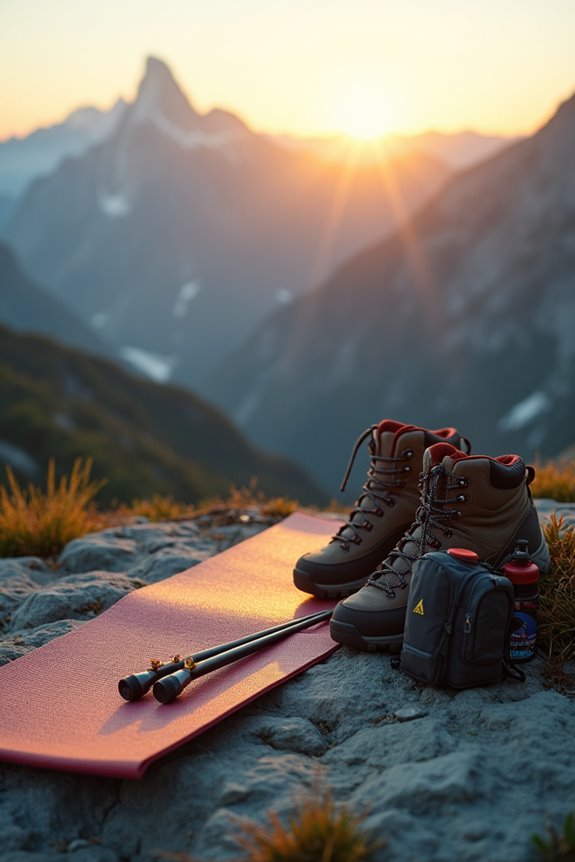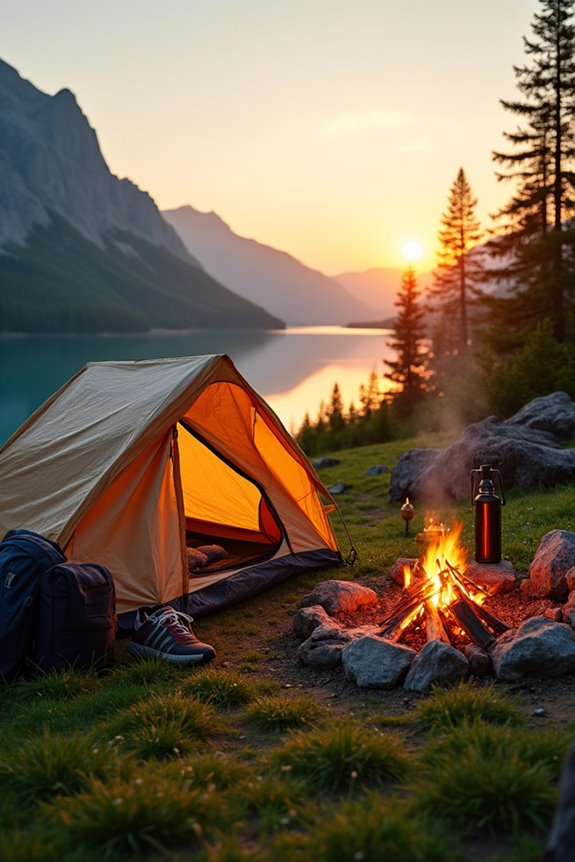Hikers can really benefit from yoga! Poses like Low Lunge and Crescent Moon stretch those tight quads and hips, while Downward-Facing Dog opens up the back and hamstrings after a long trek. For balance, Eagle and Tree Pose work wonders. Incorporating these stretches not only enhances flexibility but also keeps those hiking legs in top shape. Plus, it makes recovery feel like less of a chore. There’s so much more to explore, so keep going!
Key Takeaways
- Low Lunge effectively stretches quadriceps and enhances hip flexibility, crucial for maintaining balance and mobility during hikes.
- Downward-Facing Dog promotes spine alignment and eases tension in shoulders and hamstrings, making it ideal for post-hike recovery.
- Cat-Cow increases spinal mobility and flexibility, helping to alleviate tightness from long hikes.
- Runner’s Lunge with Chest Opener improves shoulder alignment and chest expansion, countering the effects of carrying a heavy pack.
- Supported Bridge Pose passively releases lower back tension, fostering relaxation and recovery after strenuous hiking activities.
Hip and Quadriceps Openers
When hikers hit the trails, their bodies often feel tight and weary, especially in the hips and quadriceps, which bear the brunt of those uphill climbs and long descents. To alleviate this discomfort, several yoga poses serve as fantastic hip and quadriceps openers. For instance, the Low Lunge stretches the quadriceps while targeting hip flexibility, keeping the front knee aligned. The Crescent Moon builds on that, adding an overhead reach for a deeper stretch. Downward Facing Dog with hip circles allows for dynamic movement, stretching both areas effectively. Meanwhile, poses like Eagle and Tree not only open the hips but also enhance balance. Together, these poses can transform a post-hike routine into a rejuvenating experience, helping hikers bounce back for their next adventure.
Hamstring and Calf Stretchers
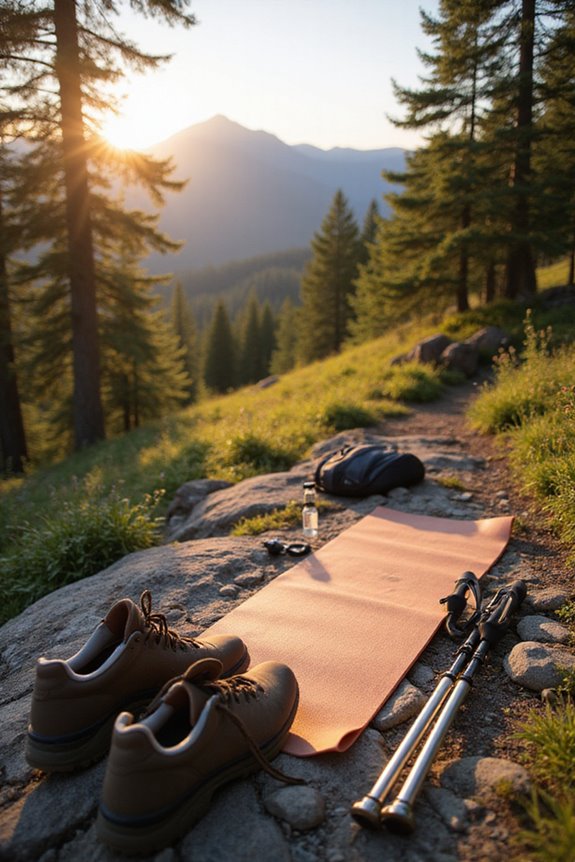
After tackling those challenging trails and loosening up tight hips and quadriceps, it’s time to turn attention to the hamstrings and calves, which often scream for relief after a long hike. Incorporating both static stretches and dynamic stretches can do wonders. Try the Standing Forward Bend (Uttanasana) for a deep stretch—just bend at the hips and let those arms hang! For a more dynamic approach, gently pedal your legs in Downward-Facing Dog to customize the intensity. If you’re feeling adventurous, Gate Pose (Parighasana) provides a side stretch that opens up those outer hamstrings. Finally, relax in Supported Bridge Pose to passively release tension, letting your body melt into the mat, and breathe deeply. Your legs will thank you!
Spine and Back Mobility
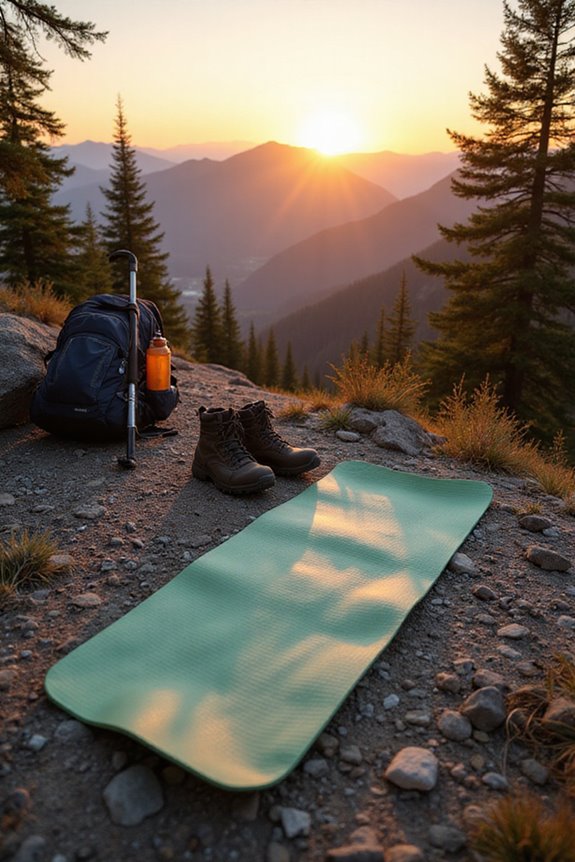
Spine and back mobility is essential for hikers who want to conquer those rugged trails without feeling like a stiff board afterward. Think about it: after a long hike, the last thing anyone wants is to waddle home like a robot! Incorporating poses like Downward-Facing Dog and Cat-Cow can greatly boost spine alignment and back flexibility. Child’s Pose offers a soothing stretch, while Sphinx Pose helps strengthen the back, making it less likely to protest after a day on the trails. Don’t forget the Seated Forward Fold, which stretches the entire backside, easing tightness. By embracing these yoga practices, hikers can maintain a happy spine, ensuring their next adventure is as enjoyable as it is thrilling.
Shoulder and Chest Openers
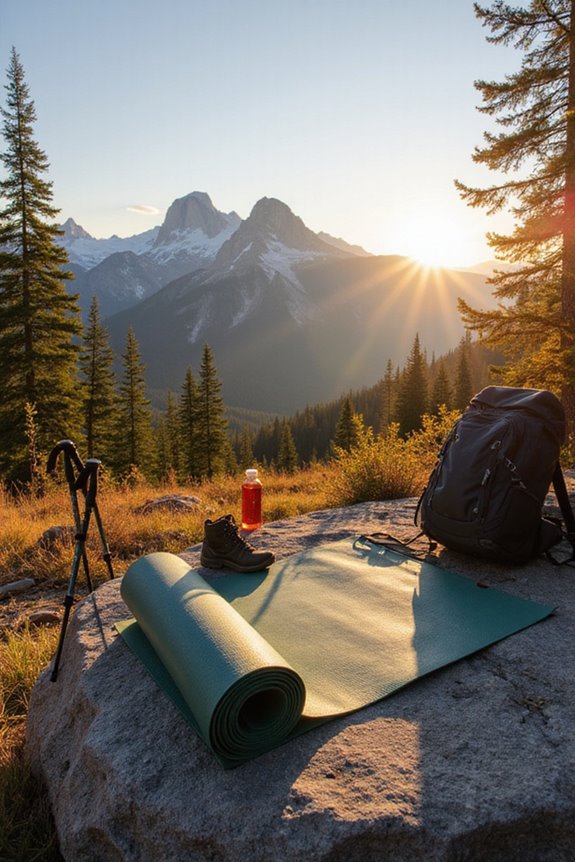
Hiking may offer breathtaking views and invigorating fresh air, but it can also leave shoulders feeling like they’ve been through a wrestling match. To counteract the forward slump caused by heavy packs or maneuvering tricky trails, shoulder and chest openers are essential. Poses like the Runner’s Lunge with Chest Opener and Cobra Variations help improve shoulder alignment and promote chest expansion. By drawing the shoulder blades down and engaging the core, hikers can enhance posture and breathing capacity. A personal favorite, the Heart Opening Crescent High Lunge, not only stretches the chest but also feels like a mini celebration for those shoulders. Embracing these poses can transform post-hike recovery, allowing hikers to breathe easier and stand taller on their adventures.
Balance and Strength Builders
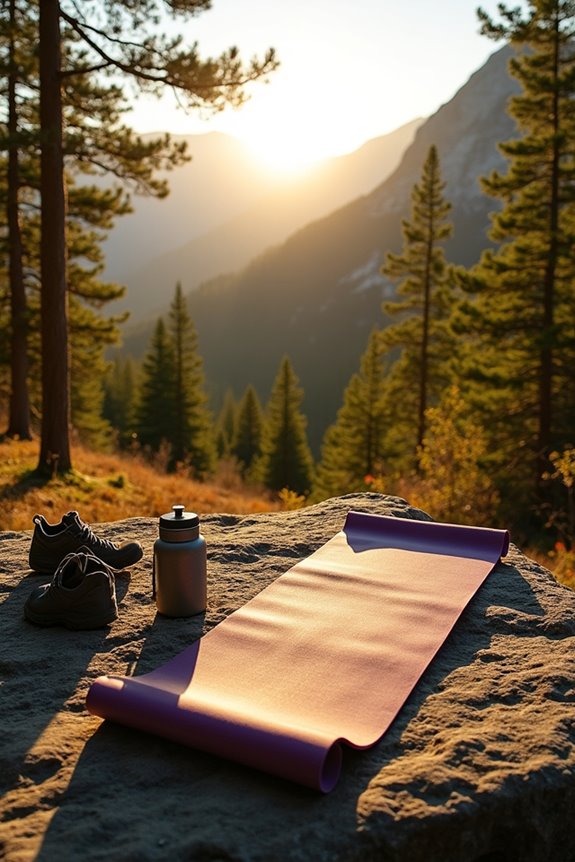
For those who love the thrill of hiking, building balance and strength can make all the difference on those rugged trails. Incorporating balance techniques like Tree Pose and Warrior 3 enhances stability, essential when maneuvering uneven surfaces. Eagle Pose not only opens the hips but also stretches those hamstrings, supporting strength development. Low Lunges and Plank Pose are fantastic for leg and core strength, helping hikers power through tough climbs. And who can forget about Half Moon Pose? It demands focus and balance, mimicking the challenges of hiking. Together, these poses create a solid foundation for any adventurer, ensuring they stay steady on their feet while enjoying the great outdoors—because a little yoga can go a long way in making every hike a memorable journey!
Recovery and Relaxation
After a long day of traversing scenic trails and conquering steep inclines, the body often feels like it’s been through a mini-war. To ease that post-hike tension, yoga becomes a trusty ally. Poses like Downward-Facing Dog work wonders, releasing tight shoulders and hamstrings. Meanwhile, Angled Child’s Pose targets aching hips, inviting deep breathing to calm the mind. Mindful movement, such as gentle stretches in Low Lunge, helps alleviate muscle soreness and promotes joint mobility. By holding restorative poses longer, hikers can foster a sense of relaxation, melting away the stress of the day. So, roll out the mat, breathe deeply, and let these poses transform recovery into a soothing ritual, preparing the body for the next adventure on the trails!
Benefits of Yoga for Hikers
While the trails may be calling, the benefits of yoga for hikers extend far beyond the mat, transforming not just bodies but also minds. Embracing various yoga styles equips hikers with improved balance and enhanced core strength, vital for those tricky uphill climbs and rocky descents. With better flexibility and body awareness, they can navigate diverse terrains with ease, reducing injury risks. Additionally, yoga techniques, like mindful breathing, boost lung capacity and help with altitude acclimatization. Mentally, it reduces stress and anxiety, fostering resilience for those challenging hikes. Overall, yoga not only strengthens bodies but also sharpens focus and confidence, making every adventure more enjoyable, and isn’t that what every hiker dreams of?
Incorporating Yoga Into Your Hiking Routine
Incorporating yoga into a hiking routine can feel like discovering a hidden path that enhances every outdoor adventure. By using simple yoga integration strategies, hikers can boost their performance and enjoyment. Pre-hike warm ups, like Half Sun Salutations, get the blood flowing and prepare those muscles for action. During long hikes, sneaking in a few gentle stretches can release tension and keep spirits high. After a trek, restorative poses work wonders for recovery, easing muscle soreness and stiffness. By planning yoga sessions on rest days, hikers can build strength gradually, making those steep inclines feel less intimidating. So, whether it’s a quick stretch or a full routine, adding yoga creates a harmonious balance, enhancing both the hike and the experience.
Tips for Practicing Yoga Outdoors
Practicing yoga outdoors can feel like a rejuvenating change that elevates the entire experience, especially when surrounded by nature’s beauty. To enhance your outdoor yoga practice, first, choose a scenic spot with a flat surface to guarantee stability. Parks or beaches are fantastic options for connecting with nature. Before you head out, plan your flow and gather essential equipment like a quality mat and sunscreen—don’t forget that pesky insect repellent! Embrace the natural elements, using a sturdy tree as a prop or practicing with friends for that community vibe. Remember to stay hydrated and check the weather to avoid surprises. Finally, take a moment after your session to reflect on the tranquility you’ve just experienced.
Frequently Asked Questions
How Often Should Hikers Practice Yoga for Optimal Benefits?
For ideal benefits, hikers should practice yoga with a frequency of at least twice a week, focusing on a practice duration that enhances flexibility, strength, and mental clarity essential for successful hiking experiences.
Can Yoga Help Prevent Hiking Injuries?
Like a sturdy tree weathering a storm, yoga benefits hikers by enhancing flexibility, strength, and balance. This practice plays an essential role in injury prevention, allowing individuals to navigate trails with greater confidence and resilience.
What Is the Best Time to Do Yoga Before Hiking?
The best time for yoga is during a morning routine, allowing pre-hike stretches to effectively warm up muscles. Engaging in yoga 30 minutes to an hour before hiking enhances flexibility and prepares the body for activity.
Are There Specific Yoga Styles Recommended for Hikers?
Like a river flowing seamlessly through a valley, specific yoga styles such as vinyasa flow and restorative yoga offer hikers essential benefits, enhancing flexibility, strength, and recovery, ultimately improving their overall hiking experience and performance.
How Can I Maintain Balance During Yoga on Uneven Terrain?
To maintain balance during yoga on uneven terrain, practitioners can utilize balance techniques and terrain adaptations. Engaging core muscles, focusing on foot placement, and enhancing proprioception are essential for maneuvering challenging surfaces effectively.

